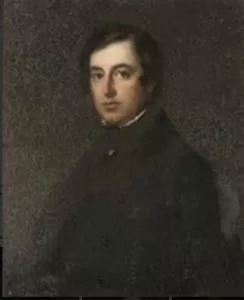
Fredric Winn Knight
This project was stimulated by the fascinating talk at our June 2019 coffee morning which was from Rob Wilson-North of the Exmoor National Park Authority. Rob talked about the Knight family of Simonsbath, who transformed the landscape of Exmoor in the 19th century. John Knight bought the Forest of Exmoor in 1820 and set about transforming it. His son, Frederic (sometimes Frederick) Winn Knight spent the greater part of his adult life farming the land around Simonsbath and worked hard to make a success of it. He was also an MP for over four decades from 1841 and was knighted in 1886.

Simonsbath in the 19th century
Many of the family’s letters were discovered, largely forgotten, in an attic but are now safely stored in the Somerset Heritage Centre in Taunton. No one has read them all yet! They give a real insight into life at the time. The letters have been scanned and now need to be transcribed and indexed. Volunteers from Minehead U3A are working on transcribing the documents and have so far completed over 300 documents. If you would like to help with this research please get in touch with . The nature of the work is that it can be done at home – with a computer.
 Some of the Knight Family documents photographed in 2016
Some of the Knight Family documents photographed in 2016

An example of a letter from the archive or Click here to see a typical document scan
The Exmoor Abstract
One transcriber is tackling the substantial multi-page ‘Exmoor Abstract’ – an account book of expenditure on fences, drainage, cottage building and construction materials purchase.
Catherine Knight (no relation!) writes “In transcribing the accounts for work carried out for the Knight family, I’ve so far covered May to November 1819. The accounts cover everything from building roads and bridges, digging canals and drains, building and repairing properties and quarrying, to paying blacksmith and labourers, providing ale for workers, buying and planting beech masts and haws, buying wheelbarrows, buckets and shovels, and buying writing paper and office supplies. Some of this really makes me stop and think. Are the beech masts planted in 1819 the beech trees and hedges on Exmoor we see today? Why did one labourer get paid more than another? How did they order or where did they get their purchases? Certainly not from the corner shop! In November 1819, the Knights spent a total of £358 9s 11d, which was a lot of money 200 years ago (over £25,000 today).”
2021
July. Phase 3 completed! click here for more info. Join the team for the next Phase (starting Autumn 2021). A presentation to update members on progress will take place in early November 2021 – watch this space and/or read the News posts!
January. Hilary Fisk, Cherrie Temple, and Di Martin gave a presentation of the project so far to a group meeting of the Local History group. Powerpoints from their presentations are available from this page; and a recording of the Zoom presentation is also available for registered and logged in users only.
2020
Summer 2020.
The project has been continued during the pandemic and has now transcribed over 80 documents, mainly letters to and from members of the Knight family, and ranging in date from the 1840s to the 1870s. The topics covered in the letters are wide-ramoney and business matters, e.g. wine-buying in bulk!, family relationships, marriages, and (sadnging – ly) deaths too; – and developments of the day, such as the railways and the postal service. The ‘every day’ story of country folk is made real in a bunch of letters from the winter of 1866/67. Here are described the hardships of farming in winter weather. William Scott, Frederick Winn Knight’s shepherd, who was recruited from the Scottish borders and who probably knew about such trials, writes in March 1867…
” we have had about a week of very trying weather for lambs. it has Bean (sic) a very hard frost with very high winds…”
December A description of winters on Exmoor in the nineteenth century was added to the year’s Advent Calendar, and can be visited here.
November An account of the work was published in Third Age Matters

A page from the u3a ‘Sources’ section of Third Age Matters magazine, published November 2020 |

|
